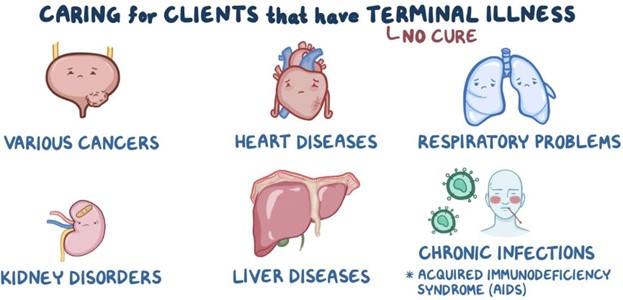The practical nurse (PN) should collect the following information during the admission assessment of a terminally ill client to an acute care facility:
Health care proxy documentation
Name of funeral home to contact
Client's wishes regarding organ donation
Contact information for the client's next of kin
The Correct Answer is A
The correct answer and explanation is:
a) Health care proxy documentation.
This is the information that the PN should collect during the admission assessment of a terminally ill client to an acute care facility. Health care proxy documentation is a legal document that appoints a person to make health care decisions for the client when they are unable to do so themselves. It is important to have this information in case the client's condition deteriorates and they need end-of-life care.
b) Name of funeral home to contact.
This is not the information that the PN should collect during the admission assessment of a terminally ill client to an acute care facility. Name of funeral home to contact is a personal preference that may or may not be relevant for the client at this point. It is not a priority for the admission assessment, and it may be insensitive or inappropriate to ask the client about it.
c) Client's wishes regarding organ donation.
This is not the information that the PN should collect during the admission assessment of a terminally ill client to an acute care facility. Client's wishes regarding organ donation are a personal choice that may or may not be applicable for the client depending on their diagnosis, prognosis, and eligibility. It is not a priority for the admission assessment, and it may be offensive or upsetting to ask the client about it.
d) Contact information for the client's next of kin.
This is not the information that the PN should collect during the admission assessment of a terminally ill client to an acute care facility. Contact information for the client's next of kin is a general demographic data that may or may not be relevant for the client's care. It is not a priority for the admission assessment, and it may be already available in the client's records.
 |
Nursing Test Bank
Naxlex Comprehensive Predictor Exams
Related Questions
Correct Answer is A
Explanation
Choice A rationale:
Instructing the client to bring all medications, supplements, and herbs currently being taken to the next clinic appointment (Choice A) is the best course of action. This allows the healthcare provider to review the client's entire medication regimen, identify any potential interactions or duplications, and make appropriate adjustments. It promotes medication safety and ensures that the client receives the most effective and safe treatment.
Choice B rationale:
Using a medication reminder system (Choice B) is a helpful suggestion but does not address the issue of potential duplications or interactions between medications. While a reminder system can improve adherence, it does not provide a comprehensive solution to the problem of multiple prescriptions for the same indication.
Choice C rationale:
Making certain a family member knows the name and use of all medications currently being taken (Choice C) is a useful practice for medication safety but may not be sufficient to address the issue of multiple prescriptions. Relying solely on a family member's knowledge may lead to misunderstandings or omissions in the medication regimen.
Choice D rationale:
Do not take any over-the-counter drugs while taking medications prescribed by a healthcare provider (Choice D) is a relevant piece of advice for medication safety. However, it does not directly address the issue of multiple prescriptions for the same indication. It is essential for the client to have a complete and accurate record of all medications, both prescribed and over-the-counter, to ensure safe and effective treatment.
Correct Answer is C
Explanation
The correct answer is choice c. Administer prescribed stool softener.
Choice A rationale:
Administering prescribed PRN sleep medications is not the highest priority. While rest is important, managing pain and preventing complications from the laceration take precedence.
Choice B rationale:
Encouraging the use of prescribed analgesic perineal sprays is beneficial for pain management, but it is not the highest priority intervention.
Choice C rationale:
Administering a prescribed stool softener is crucial because it helps prevent constipation, which can cause significant pain and strain on the perineal area, potentially worsening the laceration.
Choice D rationale:
Encouraging breastfeeding to promote uterine involution is important for postpartum recovery, but it does not directly address the immediate needs related to the fourth-degree laceration.
Whether you are a student looking to ace your exams or a practicing nurse seeking to enhance your expertise , our nursing education contents will empower you with the confidence and competence to make a difference in the lives of patients and become a respected leader in the healthcare field.
Visit Naxlex, invest in your future and unlock endless possibilities with our unparalleled nursing education contents today
Report Wrong Answer on the Current Question
Do you disagree with the answer? If yes, what is your expected answer? Explain.
Kindly be descriptive with the issue you are facing.
